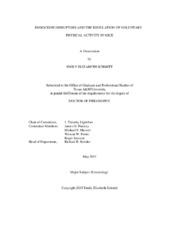| dc.description.abstract | Physical inactivity is the underlying cause of a large variety of chronic health conditions, is the second leading actual cause of death in the United States, and is a major contributor to obesity and diabetes. In spite of the strong evidence favoring physical activity as a successful and cost-effective therapy, voluntary activity levels in the United States are extremely low. Given that the most potent biological regulators of daily activity known thus far are the sex hormones (specifically testosterone) and that there are multiple environmental endocrine disruptors (ED) that directly affect sex hormone functioning, it is an intriguing possibility that environmental exposure to ED may directly affect physical activity levels. Mouse dams were treated with benzyl butyl phthalate (BBP) or a control substance (sesame oil) on days 9-16 of pregnancy. The resulting pups were weaned at three weeks of age and were randomly assigned to a four week, 10 week or 20 week sacrifice group. Daily distance, duration, and speed were measured in pups. All mice were measured weekly to determine body composition. Additionally, blood samples were extracted via a heart stick to be used for later analysis of testosterone in male pups and estrogen in female pups.
Vaginal openings in female BBP mice were significantly delayed compared to control mice. Anogenital distances in male BBP mice were significantly smaller compared to control mice at 10 and 20 weeks. There was no significant differences observed in the physical activity distance ran, duration, or speed between male and female control and treatment BBP mice. Overall, there was a significant difference in weight, lean mass, and fat mass in BBP and control male and female mice. Upon post hoc analysis, males in later life showed a significant difference in fat mass compared to controls. Lastly, there was a significant difference in serum testosterone concentration values in male mice between control and BBP at 10 weeks and at 20 weeks but no significant differences in estrogen concentration in female mice. This study was the first to analyze the effect of phthalates on physical activity in mice. | en |


